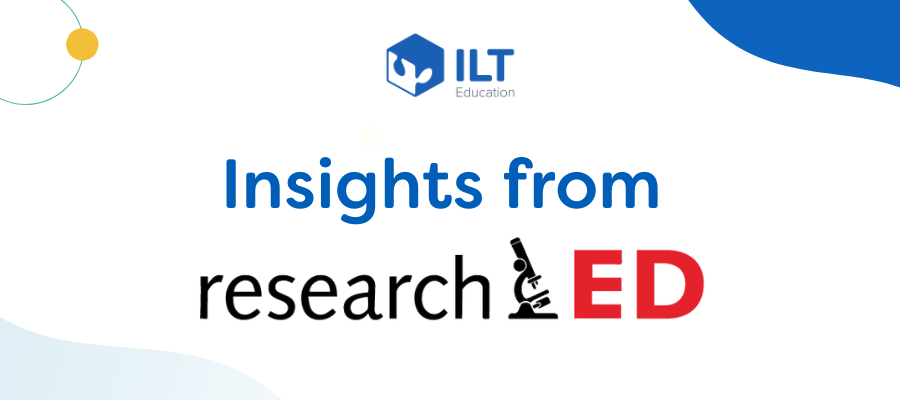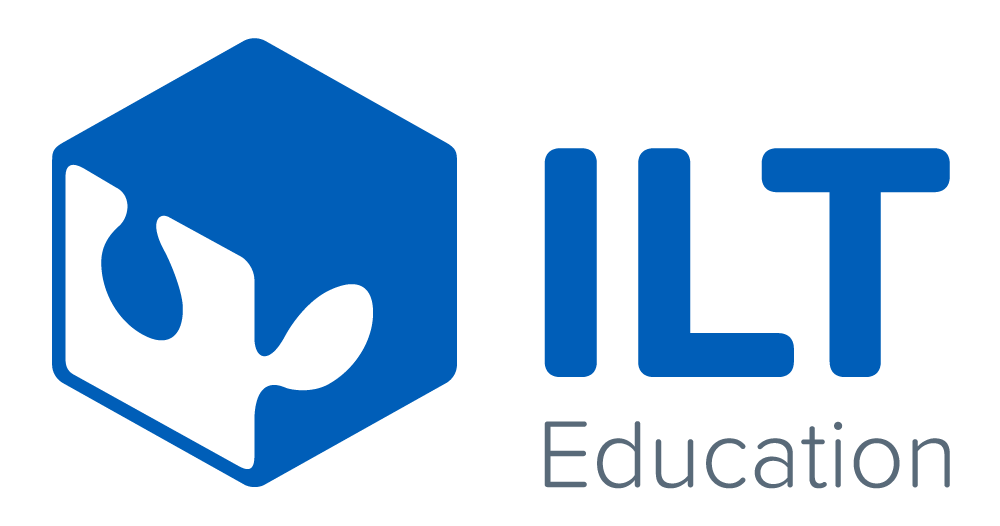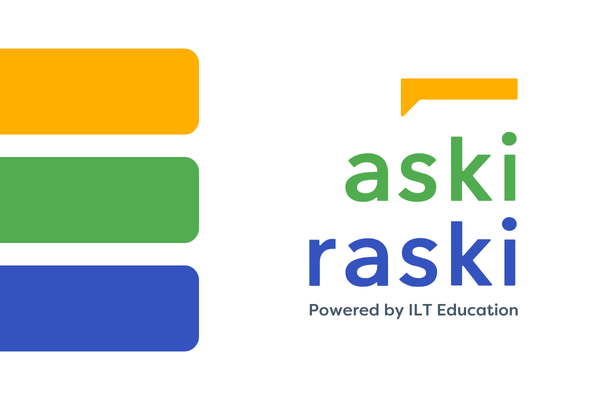- News
18/09/2025
5 Insights from ResearchED National Conference

We spent the day at ResearchED National Conference, hosted by Parliament Hill School on 6th September 2025. Here are five insights that we took away.
David Goodwin: Don’t check for learning, find the misunderstanding.
Students often perform without learning. Busy lessons, neat books, and nodding heads don’t prove retention (Coe et al., 2014; Soderstrom & Bjork, 2015). The trap is mistaking performance for learning. Fluency in the moment hides long-term gaps and can even give teachers a false sense of success. What appears smooth and well-structured in the classroom may crumble when pupils face the same ideas days later without cues or scaffolds.
David Goodwin emphasised that effective teaching is less about perfect delivery and more about disciplined improvisation. Teachers have to be prepared to shift based on what they uncover in the moment. That means building deliberate opportunities to flush out misunderstanding rather than assuming comprehension. Mini whiteboards, hinge questions, and quick quizzes are tools that reveal what has not landed. Error is the evidence you need, and designing to find it is the mark of a reflective practitioner.
Daisy Christodoulou: AI is a helper; not a tutor.
LLMs hallucinate. That’s not a glitch; it’s how they generate text (Xu, Jain & Kankanhalli, 2024). This makes them unreliable as tutors or automated experts, but it doesn’t make them useless. They shine in the background: drafting lesson resources, preparing assessment templates, automating admin, and supporting teachers with planning. Used carefully, they reduce workload and give teachers back time for thinking.
Daisy Christodoulou stressed the importance of focusing on what AI can do reliably. When combined with human markers, the efficiency is striking, and the quality of decision-making improves. She also noted that we’ve been here before. Ellis Page’s PEG project in the 1960s produced reliable but shallow essay scoring (Page, 1966–1968). PEG could be gamed by length, syntax, and surface features. Modern LLMs risk the same trap if used without oversight. And that’s why AI should augment professional judgment, not replace it.
Christine Counsell: Curriculum as story
Curriculum is more than a list. It’s a narrative that builds memory and meaning (Counsell, 2018). Counsell argued that story structures worldbuilding, scales vast events, and helps pupils remember key learning through promises and payoffs. It gives coherence across topics and creates the intellectual drama that draws students in.
She showed how curriculum as story helps teachers plant concepts early and return to them later, deepening understanding each time. For example, introducing characters, themes, or key questions in Year 7 that blossom again in Year 9 or 10. Pupils learn to spot patterns and connections because teachers carefully map these arcs. To make this work, curriculum must move between concrete and abstract.
Too much abstraction flattens the subject into bullet points and lists. Too much detail risks overwhelming with disconnected facts. Teachers hold the tension, guiding pupils through overview, depth, and back again. Done well, the curriculum becomes a story with rhythm and weight, not a checklist.
Katherine Howard: Curriculum work can retain teachers
Teacher retention links directly to agency. 38% of teachers say they have little or no say in their own PD goals (NFER, 2024). That erodes morale and contributes to the retention crisis. Kat Howard argued that curriculum must be the shared project that binds staff together and gives them intellectual purpose.
She identified four conditions that matter:
-
time and trust to develop ideas,
-
subject specificity so training respects expertise,
-
collaboration to build coherence,
-
and, leadership that curates knowledge rather than just coordinating timetables (Howard & Hill, 2020).
Teachers stay when they feel their expertise matters and when they are treated as contributors to a wider intellectual mission. Howard also challenged schools to rethink what autonomy really means. True autonomy is not teachers being left alone to sink or swim; it is teachers having genuine influence within a coherent collective endeavour. When curriculum work is visible, rigorous, and shared, staff see themselves as part of something larger, so they stay.
Carl Hendrick, Paul A. Kirschner, and Jim Heal: Instructional Illusions
We see things in classrooms that aren’t really there. Slick lessons may feel effective but can hide shallow learning. Novices misjudge difficulty because their metacognitive radar is weak. Experts struggle to explain because they forget what it feels like to be new to a discipline or domain. And schools often fall for the innovation illusion—assuming new methods must be better. Their book Instructional Illusions (Kirschner, Hendrick & Heal, 2025) identifies these traps and warns against mistaking surface polish for substance.
Examples of possible instructional illusions include the uniqueness illusion. This tells us that while pupils are individuals, their cognitive architecture is shared, so evidence-based strategies work across contexts. The expertise illusion reminds us that both students and teachers misread their own competence, leading to overconfidence and blind spots. And the innovation illusion keeps education chasing novelty instead of refining what works.
They reminded us that even the ‘science of learning’ can become an illusion if reduced to slogans: retrieval practice, spacing, interleaving, risk being treated as talismans rather than design principles.
Find more from the speakers at:
-
David Goodwin — https://www.organiseideas.com/
-
Daisy Christodoulou — https://www.nomoremarking.com/
-
Christine Counsell — https://christinecounsell.wordpress.com/
-
Kat Howard — https://www.johncattbookshop.com/symbiosis
-
Carl Hendrick — https://carlhendrick.substack.com/
-
Paul A. Kirschner — https://paulkirschnered.nl/
-
Jim Heal — https://www.jimheal.com/
References
-
Christodoulou, D. (n.d.) Comparative Judgement. Available at: https://daisychristodoulou.com/
-
Coe, R., Aloisi, C., Higgins, S. & Major, L.E. (2014) What makes great teaching? London: The Sutton Trust. Available at: https://www.suttontrust.com/
-
Counsell, C. (2018) ‘Senior Curriculum Leadership 1: (A) curriculum as narrative’, The dignity of the thing. Available at: https://christinecounsell.wordpress.com/
-
Fisher, D. & Frey, N. (2020) Better Learning Through Structured Teaching (3rd ed.). Alexandria, VA: ASCD.
-
Howard, K. & Hill, C. (2020) Symbiosis: The Curriculum and the Classroom. Suffolk: John Catt.
-
Kirschner, P.A., Hendrick, C. & Heal, J. (2025) Instructional Illusions. Woodbridge: John Catt. Maton, K. (2019)
-
No More Marking (2025) ‘AI-Enhanced Comparative Judgement (CJ)’. Available at: https://www.nomoremarking.com/
-
Page, E.B. (1966–1968) Project Essay Grade (PEG). Summarised in Measurement Inc. Available at: https://www.pearsonassessments.com/ . NFER (2024)
-
Teacher Autonomy: Outcomes and drivers. Slough: NFER. Available at: https://www.nfer.ac.uk/
-
Soderstrom, N.C. & Bjork, R.A. (2015) ‘Learning versus performance: An integrative review’, Perspectives on Psychological Science, 10(2), pp. 176–199.



